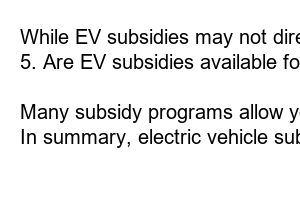전기차 보조금 조회
Title: The Electric Vehicle Subsidy Inquiry: Unlocking Savings for Greener Driving
Subheading 1: Understanding Electric Vehicle (EV) Subsidies
Looking to purchase an electric vehicle? You might have heard about the various subsidy programs available. EV subsidies are financial incentives offered by governments worldwide to promote cleaner, greener driving.
Subheading 2: The Benefits of Electric Vehicle Subsidies
With EV subsidies, the cost of purchasing an electric vehicle becomes more affordable, stimulating the adoption of sustainable transportation. These incentives can range from tax credits, cash rebates, discounted electricity rates, reduced toll fees, and even exemptions from road taxes.
Subheading 3: How Electric Vehicle Subsidies Work
Subsidies are typically offered at the national or state level and can vary depending on the country or region. Eligibility criteria, including vehicle type, battery capacity, and purchase price, may also apply. EV subsidies are usually applied at the point of purchase or through a reimbursement process, promoting immediate savings for consumers.
Subheading 4: The Impact of Electric Vehicle Subsidies on the Environment
By encouraging the transition from traditional fossil fuel vehicles to electric vehicles, subsidies play a crucial role in reducing carbon emissions and combatting climate change. Increased adoption of electric vehicles leads to decreased reliance on non-renewable energy sources, ultimately contributing to a cleaner and greener future.
Subheading 5: Challenges in Implementing Electric Vehicle Subsidies
While EV subsidies are designed to accelerate the shift towards sustainable transportation, their effectiveness ultimately hinges on factors like affordability, availability of charging infrastructure, and consumer awareness. Governments must strike a balance in providing attractive incentives while ensuring the long-term sustainability of the subsidy programs.
Subheading 6: Frequently Asked Questions (FAQs)
1. Are electric vehicle subsidies available globally?
Yes, many countries have implemented EV subsidy programs to promote the adoption of electric vehicles.
2. Can individuals leasing an electric vehicle benefit from subsidies?
In some cases, electric vehicle subsidies apply to both purchased and leased electric vehicles. Be sure to check the specific subsidy guidelines within your region.
3. What documents are typically required to claim an EV subsidy?
Documents such as proof of vehicle purchase or lease agreement, identification, and vehicle registration may be required to claim an EV subsidy.
4. Do EV subsidies cover the costs of installing home charging stations?
While EV subsidies may not directly cover the cost of home charging station installation, some regions offer separate programs or incentives to support the installation of charging infrastructure.
5. Are EV subsidies available for all electric vehicle models?
Eligibility for EV subsidies often depends on factors such as battery capacity, vehicle price, and certification under specific subsidy programs. It is essential to check the eligibility criteria for the desired electric vehicle model.
6. Can EV subsidies be combined with other incentives?
Many subsidy programs allow you to combine EV subsidies with other incentives such as grants for renewable energy installation or tax credits for home charging infrastructure.
In summary, electric vehicle subsidies offer an array of benefits, including cost savings, reduced carbon emissions, and a greener future. By understanding how these subsidies work, their impact on the environment, and the challenges faced during implementation, consumers can make informed decisions when exploring the world of electric mobility. So why not take advantage of these subsidies and make a positive impact on the planet while enjoying the advantages of electric driving?

